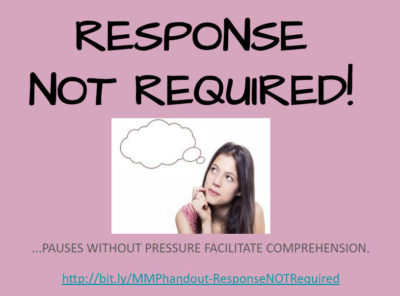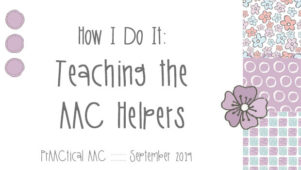Building AAC Facilitation Skills with Tabi Jones-Wohleber: MASTER PAL Training, Module 8

 Our AAC Training Series continues today and we remain extremely appreciative that West Virginia based SLP Tabi Jones-Wohleber allows us to share these presentation materials. Today’s training materials center on a topic that will help AAC interventionists strengthen their relationships with AAC learners and provide important language learning opportunities at the same time. This module, Response NOT Required, is all about interactions that engage our learners and invite them into the conversation.
Our AAC Training Series continues today and we remain extremely appreciative that West Virginia based SLP Tabi Jones-Wohleber allows us to share these presentation materials. Today’s training materials center on a topic that will help AAC interventionists strengthen their relationships with AAC learners and provide important language learning opportunities at the same time. This module, Response NOT Required, is all about interactions that engage our learners and invite them into the conversation.
The instructional time for Module 8 is about 20 minutes so this can feasibly be shared in a formal or informal sharing session before or after the school day.
:::::::::::::::::::::::::::::::::::::::::::::::::::::::::::::::::::::::::::::::::::::::::::::::::::::::::::::
Model as a MASTER PAL
Module 8: Response NOT Required
Facilitator Guidelines
When I talk about modeling without expectation of a response, I often get quizzical sideways glances. It is not an intuitive way of interacting, especially in an educational environment where responding is inherent in classroom discourse. But adopting the habit of not requiring a response opens the door for quantitative and qualitative increases in aided language interactions. Give yourself the freedom to chat, describe, reflect, state your observations, share information (while modeling). Provide opportunities for reciprocal engagement. Then keep the interaction going, even if a response is not given. In this way, compliance is averted, and meaningful opportunities for learning language are created. Remember, input (and lots of it) before output is how all language is learned.
For this session you will need:
- The Facilitator Guide
- The Presentation Slides
- The Presentation Handout
- Supplemental Handout(s): NONE
Warm-up Discussion
| Thinking Prompt | Making Connections / Talking Points |
| At the end of an important phone call, or meeting:
“I’m going to need to think about that and get back to you.” After a confrontational interaction: “I couldn’t think of how to respond at the moment, but what I should have said was….” When learning about a new topic or idea, and asked to share what you think/know/have learned: “I don’t know how well I’ll be able to explain it but….” After a MASTER PAL session: |
There are many instances in everyday interactions when we prefer to not give an immediate response. Delaying our response affords us time to process information. We may respond at a later time. We may not. Either way we do not commit to a position as our own, while we are unsure of the response we wish to give. Students learning to engage with those around them require time to process information as well.
By taking a position of Response NOT Required, we employ a mindset that takes the pressure out of interactions, while continuing to take responsibility for our role in modeling. Asking open-ended questions or using descriptive language allows the communication partner to keep the conversation moving forward (not backing the AAC User into a corner), whether or not a response is given; There is much to learn from listening and observing, and accepting that not every interaction is reciprocal. Additionally, when we take the perspective of language development, clearly modeling language without expectation of a response is how language is learned. Jane Korsten’s quote about the amount of input a child receives before beginning to speak says it all. |
The Discourse
| Topics Addressed | Slide(s) | Talking Points / Examples |
| Title Slides | 1-2 | N/A |
| Communication Review | 3-7 | Review of Model as a MASTER PAL and AAC to ensure all participants are on the same page. |
| Introduction & Warm-up Discussion | 8-11 | Explained on Slides.
See chart above for Warm-up Discussion |
| Jane Korsten Quote | 12 | Explained on Slide. INCREDIBLE statistic. |
| The misconception and challenge of interactions with AAC users | 13-14 | Misconception/ Fact: AAC supports receptive as well as expressive language. The permanent, concrete, and visual nature of of AAC allows the child to observe, review and revisit concepts to build meaning. Seeing it used by others is an important part of building meaning. When a child isn’t interested, rejects, or doesn’t use his device, it sincerely begs the question: How is it being used to build his receptive skills? (aka: Is it being modeled so he can learn how to use it expressively?)
Challenge / Fact: To effectively implement AAC in the classroom, the culture of the classroom must reflect ample learning of concepts with ample modeling on a child’s device before he/she can be expected to respond to test questions related to the content. This is a shift in the management of classroom discourse to which many are accustomed. |
| Communication is inherently motivating. | 15-18 | Slide 15 – Learning AAC requires support across competencies: linguistic, operational and social. To demonstrate communication (rather than compliance) the interaction must be inherently motivating. Providing an “out” can be the motivator and may include verbal and non-verbal communication. Avoidance, rejection or lack of engagement can prompt a communication partner to model language such as “You look like you don’t want that”, or “That doesn’t seem to interest you.” It is also important to provide the AAC user with clear options for expressing such intents with phrases such as “I want something different” or “don’t like”.
Slide 16– a revisit of Accept Multiple Modalities. Responses may take a different form than we expect. Look for communication in multiple ways. Doing it “my way” elicits compliance. Slide 17– Summary Slide 18– Revisit Statements More than Questions for additional information |
| Let’s Re-Cap | 19 |
|

Supplemental Handouts: NONE for this Module
Video Links: One Kids Place on Aided Language
Interactive Activities/Discussions: NONE for this Module
Extension Resources: NONE for this Module
Filed under: Featured Posts, PrAACtical Thinking
Tagged With: AAC partner training
This post was written by Carole Zangari




